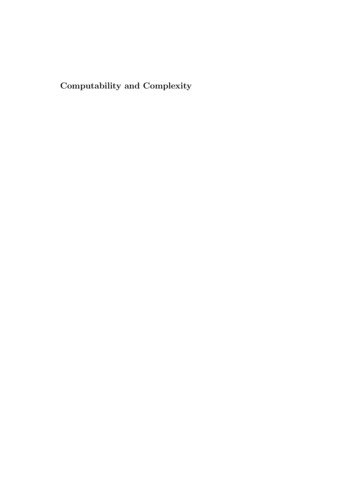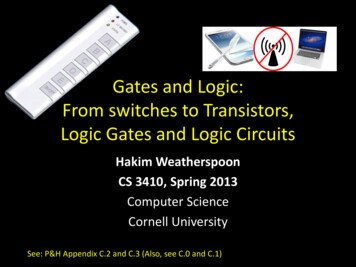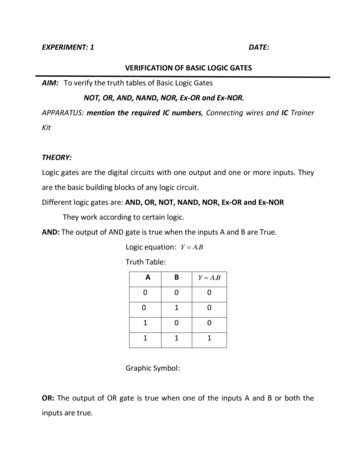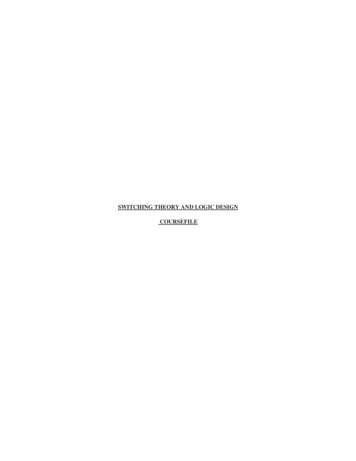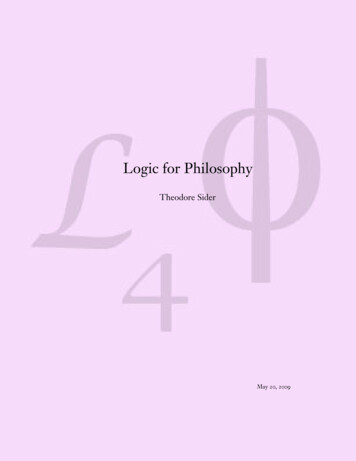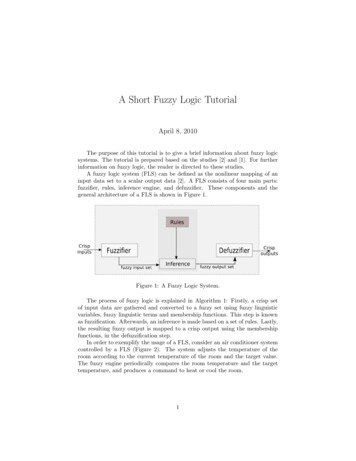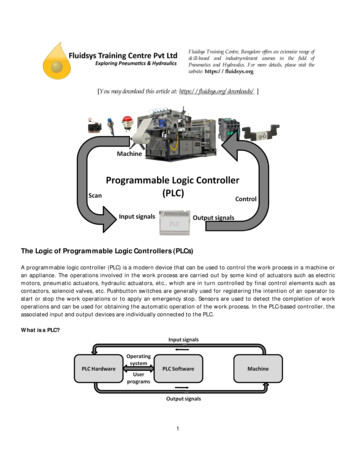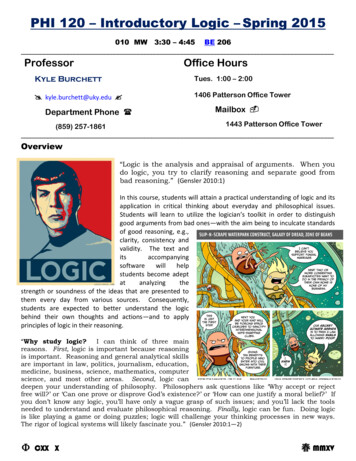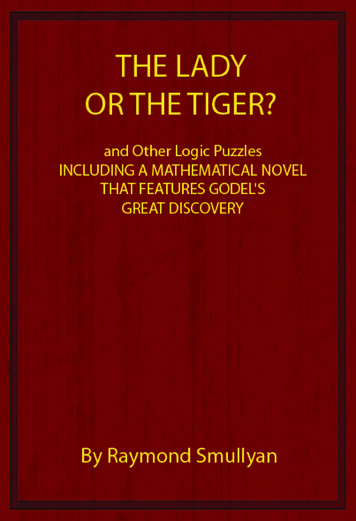
Transcription
Mathematical LogicandComputabilityJ. Keisler, K. Kunen, T. Millar, A. Miller, J. RobbinFebruary 10, 2006This version is from Spring 19870
Contents1 Propositional Logic1.1 Syntax of Propositional Logic. . . . . . . . .1.2 Semantics of Propositional Logic. . . . . . . .1.3 Truth Tables . . . . . . . . . . . . . . . . . .1.4 Induction on formulas and unique readability .1.5 Tableaus. . . . . . . . . . . . . . . . . . . . .1.6 Soundness and Confutation . . . . . . . . . .1.7 Completeness . . . . . . . . . . . . . . . . . .1.8 Computer Problem . . . . . . . . . . . . . .1.9 Exercises . . . . . . . . . . . . . . . . . . . . .5810131417212329312 Pure Predicate Logic2.1 Syntax of Predicate Logic. . . . . . . .2.2 Free and Bound Variables. . . . . . . .2.3 Semantics of Predicate Logic. . . . . .2.4 A simpler notation. . . . . . . . . . . .2.5 Tableaus. . . . . . . . . . . . . . . . .2.6 Soundness . . . . . . . . . . . . . . . .2.7 Completeness . . . . . . . . . . . . . .2.8 Computer problem using PREDCALC2.9 Computer problem . . . . . . . . . . .2.10 Exercises . . . . . . . . . . . . . . . . .37404244495155566061643 e LogicSemantics. . . . . .Tableaus. . . . . .Soundness . . . . .Completeness . . .Peano Arithmetic .Computer problemExercises . . . . . .4 Computable Functions874.1 Numerical Functions. . . . . . . . . . . . . . . . . . . . . . . . 874.2 Examples. . . . . . . . . . . . . . . . . . . . . . . . . . . . . . 871
.174.184.194.204.215Extension. . . . . . . . . . . . . . . . . . . . . .Numerical Relations. . . . . . . . . . . . . . . .The Unlimited Register Machine. . . . . . . . .Examples of URM-Computable Functions. . . .Universal URM machines . . . . . . . . . . . . .Extract and Put . . . . . . . . . . . . . . . . . .UNIV.GN commented listing . . . . . . . . . . .Primitive Recursion. . . . . . . . . . . . . . . .Recursive functions . . . . . . . . . . . . . . . .The URM-Computable Functions are recursive.Decidable Relations. . . . . . . . . . . . . . . .Partial decidability . . . . . . . . . . . . . . . .The Diagonal Method . . . . . . . . . . . . . .The Halting Problem. . . . . . . . . . . . . . . .The Gödel Incompleteness Theorem . . . . . .The Undecidability of Predicate Logic. . . . . .Computer problem . . . . . . . . . . . . . . . .Computer problem . . . . . . . . . . . . . . . .Exercises . . . . . . . . . . . . . . . . . . . . . .Mathematical Lingo5.1 Sets. . . . . . . . . . . .5.2 Functions. . . . . . . . .5.3 Inverses. . . . . . . . . .5.4 Cartesian Product. . . .5.5 Set theoretic operations.5.6 Finite Sets . . . . . . . .5.7 Equivalence Relations. .5.8 Induction on the Natural. . . . . . . . . . . . . . . . . . . . . . . . . . . . . . . . . . . .Numbers.6 Computer program documentation6.1 TABLEAU program documentation6.2 COMPLETE program documentation6.3 PREDCALC program documentation6.4 BUILD program documentation . . .6.5 MODEL program documentation . .6.6 GNUMBER program 140140142143143146.149. 149. 152. 154. 158. 160. 163. 164. 166.169. 169. 179. 179. 186. 189. 190
A A Simple Proof.199B A lemma on valuations.199C Summary of Syntax Rules204D Summary of Tableaus.207E Finished Sets.209F Commented outline of the PARAM program211G Index213List of nal Extension Rules. . . . . . . .Proof of Extension Lemma . . . . . . . . .Quantifier Rules for Pure Predicate Logic.flowchart for add . . . . . . . . . . . . . .ADD.GN . . . . . . . . . . . . . . . . . .flowchart for multiplication . . . . . . . . .assembly program for mult . . . . . . . . .MULT.GN . . . . . . . . . . . . . . . . . .Psuedocode for Predescessor . . . . . . . .flowchart for predescessor . . . . . . . . .PRED.GN . . . . . . . . . . . . . . . . . .flowchart for dotminus . . . . . . . . . . .dotminus assembly code . . . . . . . . . .DOTMINUS.GN . . . . . . . . . . . . . .divide with remainder (divrem) . . . . . .expanding part of the flowchart for divremdivrem assembly code . . . . . . . . . . . .DIVREM.GN . . . . . . . . . . . . . . . .flowchart for univ . . . . . . . . . . . . . .flowchart for nextstate . . . . . . . . . . .Jump: magnification of J box . . . . . . 2113114
2223242526272829UNIV2.GN part1 . . . . . . . .UNIV.GN part 2 . . . . . . . .UNIV.GN initialization routineHypothesis Mode . . . . . . . .Tableau Mode . . . . . . . . . .Map Mode . . . . . . . . . . . .Help box for the & key . . . .Help box for the R(.) key . . .4.123124125171174178183183
1Propositional LogicIn this book we shall study certain formal languages each of which abstractsfrom ordinary mathematical language (and to a lesser extent, everyday English) some aspects of its logical structure. Formal languages differ fromnatural languages such as English in that the syntax of a formal language isprecisely given. This is not the case with English: authorities often disagreeas to whether a given English sentence is grammatically correct. Mathematical logic may be defined as that branch of mathematics which studiesformal languages.In this chapter we study a formal language called propositional logic.This language abstracts from ordinary language the properties of the propositional connectives (commonly called conjunctions by grammarians). Theseare “not”, “and”, “or”, “if”, and “if and only if”. These connectives are extensional in the sense that the truth value of a compound sentence built upfrom these connectives depends only the truth values of the component simple sentences. (The conjunction “because” is not extensional in this sense:one can easily give examples of English sentences p, q, and r such that p,q, r are true, but ‘p because q’ is true and ‘p because r’ is false.) Furthermore, we are only concerned with the meanings that common mathematicalusage accord these connectives; this is sometimes slightly different from theirmeanings in everyday English. We now explain these meanings.NEGATION. A sentence of form ‘not p’ is true exactly when p is false.The symbol used in mathematical logic for “not” is (but in older booksthe symbol was used). Thus of the two sentences 2 2 4 2 2 5the first is false while the second is true. The sentence p is called thenegation of p.CONJUNCTION. A sentence of form ‘p and q’ is true exactly when bothp and q are true. The mathematical symbol for “and” is (or & in someolder books). Thus of the four sentences2 2 4 2 3 55
2 2 4 2 3 72 2 6 2 3 52 2 6 2 3 7the first is true and the last three are false. The sentence p q is called theconjunction of p and q.For the mathematician, the words “and” and “but” have the same meaning. In everyday English these words cannot be used interchangeably, butthe difference is psychological rather than logical.DISJUNCTION. A sentence of form ‘p or q’ is true exactly when either pis true or q is true (or both). The symbol use in mathematical logic for “or”is . Thus of the four sentences2 2 4 2 3 52 2 4 2 3 72 2 6 2 3 52 2 6 2 3 7the first three are true while the last is false. The sentence p q is called thedisjunction of p and q.Occasionally, the sentence p or q has a different meaning in everyday lifefrom that just given. For example, the phrase “soup or salad included” in arestaurant menu means that the customer can have either soup or salad withhis/her dinner at no extra cost but not both. This usage of the word “or”is called exclusive (because it excludes the case where both components aretrue). Mathematicians generally use the inclusive meaning explained above;when they intend the exclusive meaning they say so explicitly as in p or qbut not both.IMPLICATION. The forms ‘if p, then q’, ‘q, if p’, ‘p implies q’, ‘p only ifq’, and ‘q whenever p’ all having the same meaning for the mathematician:p ‘implies q’ is false exactly when p is true but q is false. The mathematicalsymbol for “implies” is (or in older books). Thus, of the four sentences2 2 4 2 3 56
2 2 4 2 3 72 2 6 2 3 52 2 6 2 3 7the second is false and the first, third and fourth are true.This usage is in sharp contrast to the usage in everyday language. Incommon discourse a sentence of form if p then q or p implies q suggests akind of causality that is that q “follows” from p. Consider for example thesentence“If Columbus discovered America, then Aristotle was a Greek.”Since Aristotle was indeed a Greek this sentence either has form If truethen true or If false then true and is thus true according to the meaningof “implies” we have adopted. However, common usage would judge thissentence either false or nonsensical because there is no causal relation betweenColumbus’s voyage and Aristotle’s nationality. To distinguish the meaningof “implies” which we have adopted (viz. that p implies q is false preciselywhen p is true and q is false) from other possible meanings logicians call itmaterial implication. This is the only meaning used in mathematics. Notethat material implication is extensional in the sense that the truth value ofp materially implies q depends only on the truth values of p and q and noton subtler aspects of their meanings.EQUIVALENCE. The forms ‘p if and only if q’, ‘p is equivalent to q’; and‘p exactly when q’ all have the same meaning for the mathematician: theyare true when p and q have the same truth value and false in the contrarycase. Some authors use “iff” is an abbreviation for “if and only if”. Themathematical symbol for if and only if is ( in older books). Thus of thefour sentences2 2 4 2 3 52 2 4 2 3 72 2 6 2 3 52 2 6 2 3 7the first and last are true while the other two are false.7
Evidently, p if and only if q has the same meaning as if p then q and if qthen p. The meaning just given is called material equivalence by logicians.It is the only meaning used in mathematics. Material equivalence is the“equality” of propositional logic.1.1Syntax of Propositional Logic.In this section we begin our study of a formal language (or more precisely aclass of formal languages) called propositional logic.A vocabulary for propositional logic is a non-empty set P0 of symbols; theelements of the set P0 are called proposition symbols and denoted by lowercase letters p, q, r, s, p1 , q1 , . . . In the standard semantics1 of propositionallogic the proposition symbols will denote propositions such as 2 2 4 or 2 2 5. Propositional logic is not concerned with any internal structure thesepropositions may have; indeed, for us the only meaning a proposition symbolmay take is a truth value – either true or false in the standard semantics.The primitive symbols of the propositional logic are the following: the proposition symbols p, q, r, . . . from P0 ; the negation sign the conjunction sign the disjunction sign the implication sign the equivalence sign the left bracket [ the right bracket ]Any finite sequence of these symbols is called a string. Or first task isto specify the syntax of propositional logic; i.e. which strings are grammatically correct. These strings are called well-formed formulas. The phrase1In studying formal languages it is often useful to employ other semantics besides the“standard” one.)8
well-formed formula is often abbreviated to wff (or a wff built using thevocabulary P0 if we wish to be specific about exactly which propositionsymbols may appear in the formula). The set of wffs of propositional logicis then inductively defined 2 by the following rules:(W:P0 ) Any proposition symbol is a wff;(W: ) If A is a wff, then A is a wff;(W: , , , ) If A and B are wffs, then [A B], [A B], [A B], and[A B] are wffs.To show that a particular string is a wff we construct a sequence of stringsusing this definition. This is called parsing the wff and the sequence is calleda parsing sequence. Although it is never difficult to tell if a short string is awff, the parsing sequence is important for theoretical reasons. For examplewe parse the wff [ p [q p]].(1) p is a wff by (W:P0 ).(2) q is a wff by (W:P0 ).(3) [q p] is a wff by (1), (2), and (W: ).(4) p is a wff by (1) and (W: ).(5) [ p [q p]] is a wff by (3), (4), and (W: ).In order to make our formulas more readable, we shall introduce certainabbreviations and conventions. The outermost brackets will not be written. For example, we writep [q r] instead of [p [q r]]. For the operators and association to the left is assumed. Forexample, we write p q r instead of [p q] r. The rules give the operator the highest precedence: (so that p qabbreviates [ p q] and not [p q] but we may insert extra bracketsto remind the reader of this fact. For example, we might write [ p] qinstead of p q.2i.e. the set of wffs is the smallest set of strings satisfying the conditions (W:*).9
The list: , , , exhibits the binary connectives in order of decreasing precedence. In other words, p q r means [p q] r and notp [q r] since has a higher precedence than . In addition to omitting the outermost brackets, we may omit the nextlevel as well replacing them with a dot on either side of the principleconnective. Thus we may write p q. . q p instead of [p q] [ q p]1.2Semantics of Propositional Logic.Recall that P0 is the vocabulary of all proposition symbols of propositionallogic; let WFF(P0 ) denote the set of all wffs of propositional logic built usingthis vocabulary. We let denote the truth value true and denote thetruth value false.A model M for propositional logic of type P0 is simply a functionM : P0 { , } : p 7 pMi.e. a specification of a truth value for each proposition symbol. This functionmaps p to pM . Or we say M interprets p to be pM .We shall extend this function to a functionM : WFF(P0 ) { , } : .And write AM for the value M(A).We writeM A(which is read “M models A” or “A is true in M”) as an abbreviation forthe equation AM ; i.e. M A means that A is true in the model M.We writeM 6 A(which is read “ A is false in M”) in the contrary case AM ; i.e. M 6 Ameans that A is false in the model M. Then the assertion M A is definedinductively by10
(M:P0 )M pM 6 pif p P0 and pM ;if p P0 and pM .(M: )M AM 6 Aif M 6 A;if M A.(M: )M A BM 6 A Bif M A and M B;otherwise.(M: )M 6 A BM A Bif M 6 A and M 6 B;otherwise.(M: )M 6 A BM A Bif M A and M 6 B;otherwise.(M: )M A Bif either M A Bor else M A B;otherwise.M 6 A BNotice how the semantical rules (M:*) parallel the syntactical rules (W:*).To find the value of A in a model M we must apply the inductive definitionof M A to the parsing sequence which constructs the wff A. For example,let us compute the value of [p q] [q p] for a model M satisfyingpM and qM . We first parse the wff.(1) p is a wff by (W:P0 ).(2) q is a wff by (W:P0 ).(3) q is a wff by (2) and (W: ).(4) [p q] is a wff by (1), (3), and (W: ).(5) [q p] is a wff by (1), (2), and (W: ).(6) [[p q] [q p]] is a wff by (4), (5), and (W: ).Now we apply the definition of M A to this construction:(1) M p by (M:P0 ) and pM .11
(2) M 6 q by (M:P0 ) and qM .(3) M q by (2) and (M: ).(4) M [p q] by (1), (3), and (M: ).(5) M [q p] by (1),(2), and (M: ).(6) M [p q] [q p] by (4),(5), and (M: ).The following easy proposition will motivate the definition of propositional tableaus.Proposition 1.2.1 Let M be a model for propositional logic and A and Bbe wffs. Then: If M A, then M A. If M [A B], then M A or M B. If M [A B], then M A and M B. If M [A B], then either M A or M B. If M [A B], then M A and M B. If M [A B], then either M A or M B. If M [A B], then M A and M B. If M [A B], then either M A B or else M A B. If M [A B], then either M A B or else M A B.12
1.3Truth TablesThe evaluation of M A is so routine that we can arrange the work in atable. First let us summarize our semantical rules in tabular form:A A andA B A B A B A B A B Now we can evaluate M A by the following strategy. We first writethe wff down and underneath each occurrence of a proposition symbol writeits value thus:[p q] [q p] and then we fill in the value of each formula on the parsing sequence underits corresponding principal connective thus:[p q] [q p] A wff A is called a tautology if it is true in every model: M A forevery model M. To check if A is a tautology, we can make a truth tablewhich computes the value of A in every possible model (each row of the truthtable corresponds to a different model). The truth table will have 2n rows ifA contains exactly n distinct proposition symbols. For example,[p q] [q p] 13
The entries in the fifth column give the values for the whole wff and as thelast of these is the wff is not a tautology.Here is a tautology: p [p q] Note that the same table shows that A [A B] is a tautology for anywffs A and B (not just proposition symbols): A [A B] This is because the wffs A and B can only take the values and just likethe proposition symbols p and q.1.4Induction on formulas and unique readabilityIn this section (unless we mention otherwise) by formula we mean unsimplified fully-bracketed well-formed formula.PRINCIPLE OF INDUCTION ON FORMULAS. To prove that all formulas have a given property PROP: Show that every p P has the property PROP. Show that if Ais formula with property PROP then A has PROP. Show that if Aand Bare formula with property PROP and * is one of{ , , , } then [A B] has property PROP.This principle can be proved by using ordinary induction on the naturalnumbers (see section 5.8).Lemma 1.4.1 Every formula has the same number of [’s as ]’s.14
This is clear for every p P since they contain no [’s or ]’s. The inductivestep in the case of does not add any brackets and in the case of [A B]one of each is added to the total number in Aand B.Lemma 1.4.2 In every formula, every binary connective is preceded by more[’s than ]’s.Here the basis step is true since atomic formulas contain no binary connectives. The inductive step [A B] since any binary connective occurring inAhas one more [ occurring before it in [A B] than it does in A. The mainconnective * is ok since Aand Bhave a balanced set of brackets by the preceding lemma. And the binary connectives of Bare ok (with respect to [A B])since Ahas a balanced set of brackets.Theorem 1.4.3 UNIQUE READABILITY. Each propositional formula Cis either apropositional symbol, is of the form A, or can be uniquely written in theform [A* B] where Aand Bare formulas and * is a binary connective.The or * in this theorem is called the main connective of C. The cases thatC is a proposition symbol or starts with is easy. To prove the theoremsuppose that C is [A B], and there is another way to read C say [A0 0 B0 ].Then either Ais a proper initial segment of A0 or vice-versa. Without lossof generality assume that Ais a proper initial segment of A’. But then * isa binary connective which occurs somewhere in A’ and so must be precededby unbalanced brackets, but this contradicts the fact that the brackets mustbe balanced in A.The proof shows that the main connective of a formula can bepicked out simply by finding the unique binary connective suchthat brackets are balanced on either side of it.This result shows that the brackets do their job. Its need can be explainedby seeing that the definition of truth value is ambiguous without brackets.For example, p q r is not well-defined since if the model M is defined byM(p) , M(q) , and M(r) :M [p [q r]]15
butM [[p q] r].In the simplified form obtained by dropping brackets the correspondingrule for picking out the main connective of Ais the following:The main connective of Ais the rightmost connective of lowestprecedence which is preceded by an equal number of [’ s as ]’s inthe simplified form of A. (This is again proved by induction, ofcourse).The definition of truth value is an example of definition by induction.PRINCIPLE OF DEFINITION BY INDUCTION. A function with domain WFF can be defined uniquely by giving: A value f(p) for each p P0 ; A rule for computing f( A) from f(A); For each binary connective *, a rule for computing f([A* B]) from f(A)and f(B).The abbreviated form of A(dropping parentheses) is another example.Another example is in the first exercise set. Other good examples are thetree height of a formula, and the result of substituting a formula Afor apredicate symbol p in a formula. The height(A) is defined by height(p) 1 for any p P0 height( A) height(A) 1 height([A B]) max(height(A),height(B)) 1The following principle is more general and corresponds to the strongform of induction on natural numbers:PRINCIPLE STRONG OF INDUCTION ON FORMULAS. To provethat all formulas have a given property PROP: Show that every p P0 has the property PROP. Show that for any formula Aif all formulas of length less than Ahaveproperty PROP; then Ahas property PROP.16
1.5Tableaus.Often one can see very quickly (without computing the full truth table)whether some particular wff is a tautology by using an indirect argument.As an example we show that the wff p [q [p q]] is a tautology. If not,there is a model M for its negation, i.e. (1) M [p [q [p q]]. From(1) we obtain (2) M p and (3) M [q [p q]. From (3) we obtain (4)M q and (5) M [p q]. From (5) we conclude that either (6) M por else (7) M q. But (6) contradicts (2) and (7) contradicts (4). Thusno such model M exists; i.e. the wff p [q [p q]] is a tautology asclaimed.We can arrange this argument in a diagram (called a tableau):(1) [p [q [p q]]](2)pby (1)(3) [q [p q]]by (1)(4)qby (3)(5) [p q]by (3) QQQQ (6,7)Q p qby (5)The steps in the original argument appear at nodes of the tableau. Thenumber to the left of a formula is its step number in the argument; thenumber to the right is the number of the earlier step which justified the17
given step. The two branches in the tree at node (5) correspond to the twopossibilities in the case analysis. There are two ways to move from formula(1) down to the bottom of the diagram: viz. (1)-(2)-(3)-(4)-(5)-(6) and (1)(2)-(3)-(4)-(5)-(7); along each of these two ways there occurs a formula andits negation: viz (2) and (6) for the former way and (4) and (7) for the latter.Before explaining the method of tableaus precisely we generalize slightlyour problem. If H is a set of wffs and M is a model we shall say M modelsH (or M is a model of H) and write M H iff M models every elementA of H:M H iff M A for all A H.Of course, when H is a finite set, say H {A1 , A2 , . . . , An } then M Hif and only if M models the conjunction: M A1 A2 . . . An but thenotation is handy (especially for infinite sets H).A set of sentences H is called semantically consistent iff it has a model;i.e. M H for some M. Now a wff A is a tautology if and only if the set{ A} consisting of the single wff A is inconsistent so we shall study theproblem of deciding if a given finite set H of wffs is consistent rather thanthe special case of deciding whether a given wff is a tautology.A wff A is called a semantic consequence of the set of wffs H iff everymodel of H is a model of A. Evidently, A is a semantic consequence of H ifand only if the set H { A} is semantically inconsistent.A tree T is a system consisting of a set of points called the nodes of thetree, a distinguished node rT called the root of the tree, and a function π,or πT , which assigns to each node t distinct from the root another node π(t)called the parent of t; it is further required that for each node t the sequenceof nodesπ 0 (t), π 1 (t), π 2 (t), . . .defined inductively byπ 0 (t) tandπ k 1 (t) π(π k (t))terminates for some n at the root:π n (t) rT .18
The nodes π 1 (t), π 2 (t), π 3 (t), . . . are called the proper ancestors of t; a nodet0 is an ancestor of t iff it is either t itself or is a proper ancestor of t. Thusthe root is an ancestor of every node (including itself). Conversely, the nodess whose parent is t are called the children of t; the set of children of t isdenoted by π 1 (t):π 1 (t) {s : π(s) t}.A node of the tree which is not the parent of any other node (i.e. not in therange of the function π) is called a terminal node. A node is terminal if andonly if it has no children.A sequenceΓ (t, π(t), π 2 (t), . . . , rT )starting at a terminal node t is called a branch or finite branch. Thus finitebranches and terminal nodes are in one-one correspondence.In a tree with infinitely many nodes we may have an infinite branch. Aninfinite sequenceΓ (p0 , p1 , p2 , . . .)is an infinite branch is an infinite branch if p0 is the root node and for everyn pn 1 is a child of pn .It is customary to draw trees upside down with the root at the top andeach node connected to its parent by a line. For example, in the treeabd!!!!!aaaaae cHHHHfgthe root is a; the parent function is defined by π(b) π(c) a, π(d) b,π(e) π(f ) c, π(g) e; the children of the various are given by π 1 (a) {b, c}, π 1 (b) {d}, π 1 (c) {e, f }, π 1 (e) {g}, π 1 (d) π 1 (e) π 1 (g) ; the terminal nodes are d, f, g; and the branches are (d, b, a),(f, c, a), (g, e, c, a).By a labeled tree for propositional logic we shall mean a system (T, H, Φ)consisting of a tree T, a set of wffs H which is called the set of hypotheses,19
and a function Φ which assigns to each nonroot node t a wff Φ(t). In order toavoid excessive mathematical notation we shall say “A occurs at t” or even“A is t” in place of the equation A Φ(t). We will also denote the labeledtree by T rather than the more cumbersome (T, H, Φ),A wff which which occurs at a child of a node t will be called a childwff (or simply child) of t, and a wff at a child of a child of t will be calleda grandchild wff of t. A wff which is either in the hypothesis set H or elseoccurs at some ancestor node of t is called an ancestor wff of t or simply anancestor of t.We call the labeled tree T a propositional tableau 3 iff at each nonterminal node t one of the following conditions holds: t has an ancestor A and a child A. t or its parent has an ancestor A B a child A and grandchild B. t has an ancestor [A B] and two children A and B. t has an ancestor A B and two children A and B. t or its parent has an ancestor [A B] a child A and grandchild B. t has an ancestor A B and two children A and B. t or its parent has an ancestor [A B] a child A and grandchild B. t has an ancestor [A B] and two children A B and A B. t has an ancestor [A B] and two children A B and A B.In each case, the ancestor wff is called the node used at t and the otherwffs mentioned are called the nodes added at t. What this definition saysis this. To build a propositional tableau start with a tree T0 consisting of a3This definition is summarized in section D.20
single node (its root) and a set H hypotheses. Then extend the tableau T0to a tableau T1 and extend T1 to T2 and so on. Each extension uses one ofa set of nine rules which apply to a propositional tableau T to extend it to alarger propositional tableau T0 . These rules involve choosing a terminal nodet of T and a formula C which appears on the branch through t. Dependingon the structure of the wff C we extend the tree T by adjoining either onechild, one child and one grandchild, or two children of t. At the new nodeor nodes we introduce one or two wffs which are well formed subformulas ofthe wff C.For reference we have summarized the nine extension rules in Figure 1.This figure shows the node t and a formula C above it; the vertical dotsindicate the branch of the tableau through t so the figure shows C on thisbranch. (It is not precluded that C be at t itself.) Below t in the figureare the wffs at the children of t, and when appropriate the grandchild of t.When both child and grandchild are added together in a single rule, they areconnected by a double line. Thus the rule yields one child, the , ,and rules each yield one child and one grandchild, and the remainingfive rules yield two children.Any finite tableau within the memory limits of the computer can be builtwith the TABLEAU program. The Why command shows which formula wasused at each node of the tableau.1.6Soundness and ConfutationWe say that a formula A is along or on a bra
In this book we shall study certain formal languages each of which abstracts from ordinary mathematical language (and to a lesser extent, everyday En-glish) some aspects of its logical structure. Formal languages differ from natural languages such as English in
